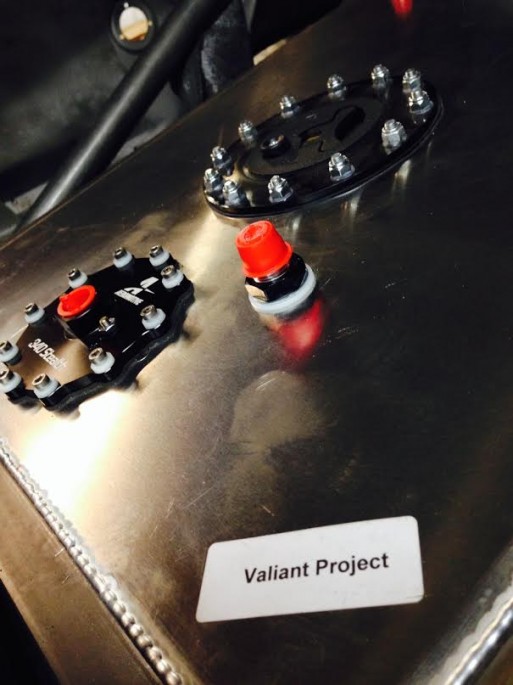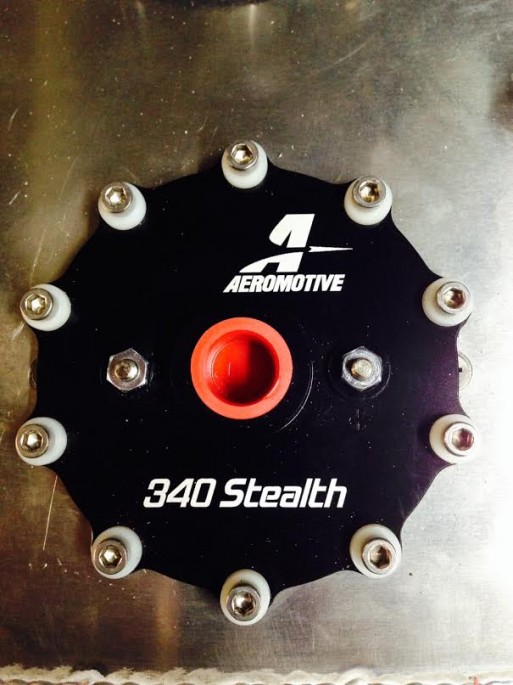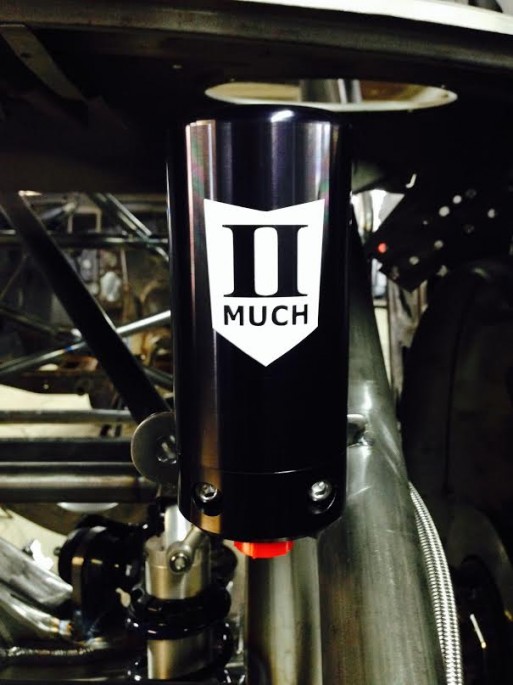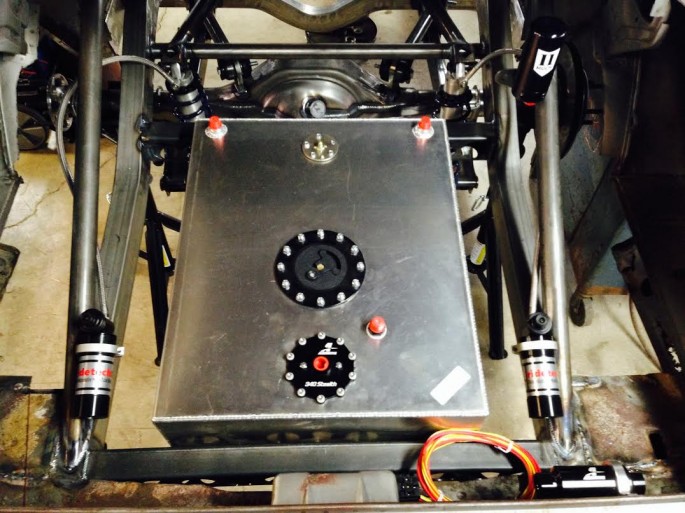Project Violent Valiant is coming right along. Kevin Tully has really been burning the candle at both ends at his shop, Hot Rod Chassis and Cycle in Illinois. We’ve seen the car start as a clean little straight six Valiant and then the cutting started. The fabrication work has been going on hot and heavy with the roll cage and suspension pieces getting mounted. Kevin also worked on the mounts for the Aeromotive fuel cell and the associated pieces with it. This update will show and talk about the 20-gallon Aeromotive 340 Stealth fuel cell and the cool II Much Fabrication fuel vent which will be a big part of keeping this car fun to drive, non-smelly, and safe.
We didn’t really have much of an appreciation for the fuel vent situation before talking to John Ulaszek at II Much Fabrication. He and John Parsons have spent a couple years of their lives devoted to these products and their results show. Kevin Tully swears by them and virtually everyone in the tank business from Rick’s to Aeromotive tells their customers to use their parts when completing their fuel system.
This update is about the parts, baby! Let’s learn about what’s storing and moving the fuel and what is going to keep the whole system breathing while containing spillage and vapor!

We’ll start by introducing you to this fairly simple looking canister which is a lot more than that. This is a II Much Fabrication fuel tank vent and it is one of the more interesting pieces on the car. In high performance carb’d applications and especially return stye EFI systems, there is a lot of fuel and a lot of fuel vapor being moved around. With a typical vent in an inboard fuel cell or other tank this means that your car is virtually guaranteed to have the odor of gasoline in it after it has been running for any amount of time. In the past, solutions like charcoal cans have been used to knock the smell down but the problem there is that eventually the charcoal soaks up the vapor and you can envision why that is bad. Another issue that II Much addresses with their vents is fuel spillage. How many times have you see cars at the autocross or drag strip with fuel pouring out of them around a corner or at the hit of the throttle? This piece eliminates the ability for the fuel to escape like that, taking care of that issue. Using an engineered mechanical approach, these vents are not filled with absorbing material or charcoal. There is a vapor trap in the unit that stops the smell and stops fuel from escaping. Now you are wondering if they are restrictive and if they hurt the fuel system’s ability to work right. They are not. Aeromotive has tested these units that there was zero degradation in fuel system performance up to 1,400hp on their testing equipment. The company offers a few different styles of vents to fit the needs of their customers. In this case, Hot Rod Chassis and Cycle chose the side mount style fuel vent. We’ll talk more about these pieces a little later on in the story.

If we have a fuel tank vent, then we must have a fuel tank, right? In this case, Tully spec’d out an Aeromotive Stealth 340 20-gallon cell. This is the right piece for the job because the 340 pump can handle 700+ horsepower, there is baffling in the tank to keep the pump submerged in fuel during hard driving (like the drags and autocross) and the dimensions “fit the hole” perfectly. This is an off the shelf piece from Aeromotive. The part # is 18665.

The 340 pump made sense for this car because of the power levels expected from the Chrysler wedge engine that will power it, the quietness of operation (the car is going to be driven extensively and ain’t nobody got time to listen to a fuel pump scream for hours on end), and it has a strong reputation for durability. The 340 is flexible as well in that it can be used in pulse modulated fuel systems as well as those using more traditional styles of regulators.

An Aeromotive filter will be used as well. We’re not going to be sidelined somewhere because a gas station in the sticks has crud in their tank. Aeromotive filters move big volume while filtering down to miniscule sizes like 10 microns. The replaceable element means that this housing will live with the car for as long as it is rolling around, terrorizing the streets…and that is going to be a good, long time.

You’ve seen Kevin’s work to this point so you know he could have constructed a fuel cell. It speaks well for the Aeromotive guys that he went with their unit as a fabricator. We know lots of these guys and they aren’t exactly known for throwing compliments around like Skittles. Check out all of Aeromotive’s products by visiting – www.http://aeromotiveinc.com/

Here’s another look at the cell situated in the mounts that Kevin made for it. We’ve spent the last few updates talking about the back of the car. Next week we’ll be showing you lots of the action happening up front.

Kevin made a mount for the II Much Fabrication vent on one of the roll cage down bars. The guys at II Much provide detailed mounting directions with their products because it is 100% essential for proper operation. This is the reason they offer bulkhead mount vents, this side mount, and one that the call the dual mount that offers a lot of flexibility in applications where space is a big concern. We talked to the guys at II Much and they take a lot of pride in these products and have spent a few years refining them and ONLY them. They want to make the best ones of the market and they are very passionate about it. That’s really neat in our book. They are 100% made in the USA and are on projects all over the country. Look for us to do more tech with these fellows in the future. You can check out all of their products by visiting – http://www.iimuchfabrication.com/


























Hmmm. This is gonna be one sick Machine – how much of my 401 will it take to get my 66 vali built just to the point of being a roller.? I wonder I wonder. Retirement or hotrod. Tuff choices – but choices non the less. KILLER CAR. CANT WAIT
FOR NEW UPDATES.
Give me a ring Mr. Gilchrist. We can discuss exactly what you’d like to do with your car and give you an estimate.
Guessing that vent can is the same as a forced hot water home heater expansion tank, or sealed steam system
[img]http://upload.wikimedia.org/wikipedia/commons/thumb/d/d3/Expansion_tank.jpg/220px-Expansion_tank.jpg[/img]
Anonymous,
Interesting idea, but our venting system needs to allow air into the tank as fuel is consumed otherwise negative pressure with respect to atmospheric pressure will develop which can cause deformation, fuel pump cavitation or overheating. Thanks for the link.
The vent setup looks very sano. I’m building an 87 Saleen notch clone and the fuel tank is the Aeromotive version of the ’03 Cobra tank with an Eliminator pump. There will be a full cage and a mostly empty trunk for street driving. The engine is a bit over 1000 N/A 200-300 more with dry N2O. Which vent is recommended?